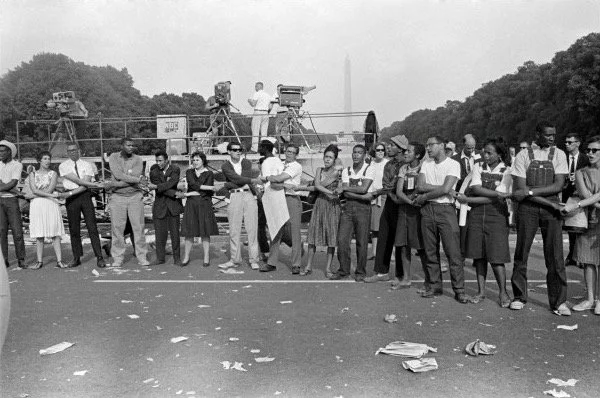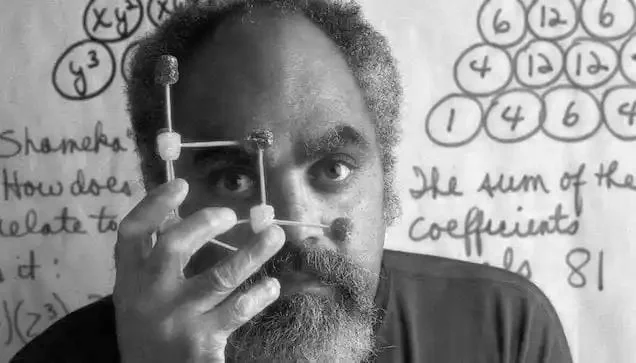EXPLORE A LIVING LEGACY
*
EXPLORE A LIVING LEGACY *
1935
Robert Parris Moses was born on Jan. 23, 1935, in New York City, one of three children of Gregory H. Moses, a janitor, and Louise (Parris) Moses, a homemaker.
He was raised in the Harlem River Houses, a public housing complex, and attended Stuyvesant High School, a selective institution with a strong emphasis on math. He played basketball and majored in philosophy and French at Hamilton College in Clinton, N.Y.
1957
He earned a master’s degree in philosophy in 1957 from Harvard University, and was working toward his doctorate when he was forced to leave because of the death of his mother and the hospitalization of his father. He moved back to New York, where he taught math at the private Horace Mann School in the Riverdale section of the Bronx.
1960
He left his job as a high school teacher in New York City for Mississippi, where he organized poor, illiterate and rural Black residents, and quickly became a legend among civil rights organizers in a state known for enforcing segregation with cross burnings and lynchings. Over the next five years, he helped to register thousands of voters and trained a generation of organizers in makeshift freedom schools.
He volunteered for and later joined the staff of the Student Nonviolent Coordinating Committee. He was also a director of the Council of Federated Organizations
1964
Mr. Moses helped to start the 1964 Mississippi Freedom Summer Project, which recruited college students in the North to join Black Mississippians in voter registration campaigns across the state.
Because black people were excluded from the all-white Mississippi delegation at the Democratic National Convention. Mr. Moses helped create the Mississippi Freedom Democratic Party, which sought recognition as the state’s delegation instead.
1965
He spoke at his first antiwar protest, in Washington, D.C. “The prosecutors of the war,” he said, were “the same people who refused to protect civil rights in the South”
1970
Mr. Moses and his wife, Janet, moved to Tanzania, where they lived in the 1970s and where three of their four children were born. After eight years teaching in Africa, Mr. Moses returned to Cambridge, Mass., to continue working toward a Ph.D. in the philosophy of mathematics at Harvard.
1982, Mr. Moses was frustrated that his 8th grade daughter's school did not offer algebra, so he asked the teacher to let her sit by herself in class and do more advanced work.The teacher invited Mr. Moses, who had just received a MacArthur “genius” grant, to teach Maisha and several classmates. The Algebra Project was born.
1982, Mr. Moses was frustrated that his 8th grade daughter's school, MLK Jr School, did not offer algebra, so he asked the teacher to let her sit by herself in class and do more advanced work. The teacher invited Mr. Moses to teach Maisha and several classmates. Moses, who had just received a five-year MacArthur Foundation Fellowship, continued this teaching in middle school math classes to ensure students would graduate prepared for a college prep sequence in high school, which he considered the minimal acceptable “floor” of math literacy. Moses began using his experience in these classrooms to develop AP’s “Transition Curriculum”, to enable a transition from arithmetic to algebraic thinking. This was the beginning of the Algebra Project.
By the late 80s, and with the collaboration of Cynthia Silva (Parker) and Jacqueline Rivers, the Algebra Project secures a fiscal agent paving the way for national growth in the 1990s. Jackie begins spearheading the Algebra in Middle Schools (AIMS) initiative in Boston Public Schools.
1982
1990’S
The Algebra Project formally incorporates as a non-profit in 1991, with the mission of raising the floor of math literacy and the belief that math literacy is the key to 21st-century citizenship.
In 1991, Moses enlists the help of Dave Dennis and his company, Positive Innovations, to initiate a Southern Initiative Algebra Project, beginning in Mississippi and later expanding to the Carolinas, Georgia, Alabama, Louisiana, and Arkansas.
As the initiative expands, sister organizations like the Chicago Algebra Project, New York City Algebra Project, Indianapolis Algebra Project and Baltimore Algebra Project begin incorporating.
Moses enlists the help of Bill Crombie and Jim Burruss to begin developing the Training of Trainers program in order to produce more facilitators of Algebra Project Professional Development versed in the Transition Curriculum and the Algebra Project’s Five-Step Curricular Process.
Moses recruits Ben Moynihan to coordinate a team that produces an African Drums & Ratios curriculum for elementary school students.
By the late 90’s and with support from the Open Society Institute, the National Science Foundation, the MacArthur Foundation, The Lilly Endowment, the Edna McConnell Clark Foundation, and others, the Algebra Project stretches coast-to-coast, reaching 10,000 middle school students per year.
Moses initiates a high school adaptation of the Algebra Project at Lanier High School in Jackson, Mississippi.
Bob Moses is the inspiration for the 2000 movie “Freedom Song,” starring Danny Glover.
In 2001, Moses and fellow activist and journalist Charles E. Cobb Jr. published Radical Equations: Civil Rights from Mississippi to the Algebra Project, about Moses's life and work in civil rights and education
In 2001, Moses, alongside SNCC veteran and journalist Charlie Cobb Jr., publish Moses’ memoir Radical Equations: Civil Rights from Mississippi to the Algebra Project, which chronicles Moses’ journey from the voting rights movement to his creation of the Algebra Project.
Enabled by an NSF grant and fiscal support from donors and foundations, Moses collaborates with research mathematicians Greg Budzban, Ed Dubinsky, David Henderson, and others to develop high school mathematics curriculum.
From 2002 to 2006, Moses developed the first Algebra Project math cohort model at Lanier high school, which would become an instrumental practice for ensuring students entering high school performing in the lowest quartile could pass state exams, graduate on time in four years, and graduate prepared for college or career mathematics without remediation.
In the 2006-2007 academic year, Moses was named a Frank H. T. Rhodes Class of '56 Professor at Cornell University.
During his visits to the New Orleans Algebra Project, an idea is generated that quality education as a Constitutional right is a necessary precursor to raising the floor of math literacy. These discussions lead to a national working conference at Howard University in 2005, and a collection of essays published in 2010, both titled Quality Education as a Constitutional Right. QECR remains an ongoing effort with monthly meetings.
Moses becomes an Eminent Scholar at the Center for Urban Education and Innovation at Florida International University, and begins an Algebra Project implementation in Miami-Dade schools.
2000’s
2010s
Bob Moses is the inspiration for the 2000 movie “Freedom Song,” starring Danny Glover.
In 2001, Moses and fellow activist and journalist Charles E. Cobb Jr. published Radical Equations: Civil Rights from Mississippi to the Algebra Project, about Moses's life and work in civil rights and education
After receiving an NSF grant, the Algebra Project begins a study on high school math cohorts in: Mansfield, Ohio; Ypsilanti, Michigan; Eldorado, Illinois; and Los Angeles, California.
In the 2011-2012 academic year, Moses was a visiting scholar at the Center for African American Studies at Princeton University.
In 2016, the Algebra Project and partner organizations receive support from the NSF INCLUDES programs to organize working conferences to design a national alliance in support of K-12 math literacy. This lead to the formation of the We the People – Math Literacy for All Alliance, which continues to meet weekly.
Inspired by the math literacy organizing happening in the community, the Florida Local Alliance for Math Literacy and Equity (FLAME) is formed at FIU in collaboration with community organizations, colleges, and local school districts.
In 2018, with Algebra Project Board Member Danny Glover, Courtland Cox of the SNCC Legacy Project, and others, Moses meets with Senator Bernie Sanders and Representative Bobby Scott about the need for increasing federal investment in K-12 math education.
In 2019, the WTP-ML4A holds a national conference in Washington, D.C. and a public briefing on Capitol Hill calling for the federal government to increase support for K-12 mathematics education.
In July of 2020, a QECR virtual townhall was held with 1,000 participants. This established the qualityeducationasaconstitutionalright.org website.
In April 2021, Moses initiated a National Consensus Project to Eliminate Caste in America’s Classrooms, with a series of discussions with students, teachers, researchers and activists. In the same month, Moses was inducted into the American Academy of Arts & Sciences.
Celebration of Life for Bob Moses at St. Mary’s of the Annunciation Church and Starlight Square
By the time of his passing, Dr. Moses had received 17 honorary doctorate degrees and 9 NSF awards. The Algebra Project throughout its duration has been involved in 13 NSF awards so far.
Building on previous studies that Moses was involved in, the Algebra Project partners with ETS to explore new assessments on student collaboration and with Kennesaw State University on an integration of computational thinking in the teaching of mathematics in secondary schools.
In 2022, the Algebra Project and the We the People – Math Literacy for All Alliance host an online national conference to push forward Moses’ vision of raising the floor of math literacy.
In 2023, the American Mathematical Society published a tribute article featuring 26 collaborators who knew Moses to celebrate his legacy.








